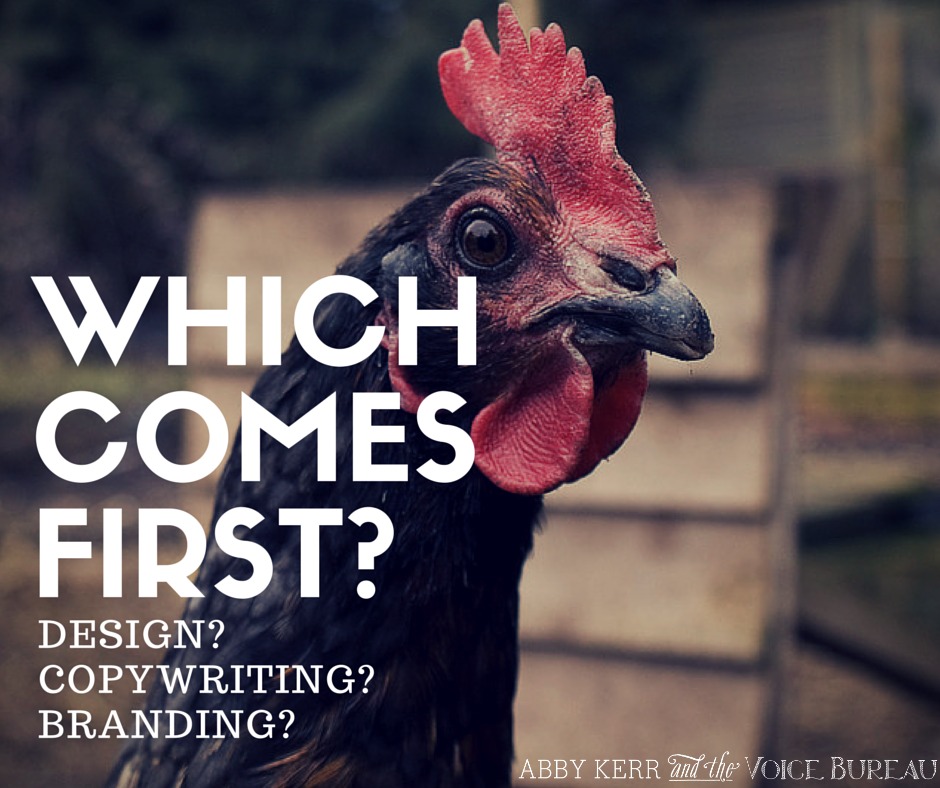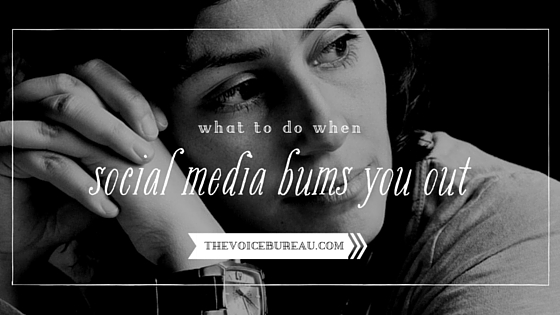I meet a lot of new clients with this dilemma: which comes first, the design of my new website, new copy for my site, or “branding” (whatever that is).
 It’s the classic chicken-or-the-egg debate: which comes first? What’s the best strategic place to start? And if you start with the “wrong” element first, will it mess up everything else?
It’s the classic chicken-or-the-egg debate: which comes first? What’s the best strategic place to start? And if you start with the “wrong” element first, will it mess up everything else?
I love it when people ask these questions with an open mind. Because, truly, there is a best place to start.
Assuming you’re working with experienced creative professionals who understand content strategy, truly want your project to succeed, and don’t have too much ego on the line (because your creative project is not a p*ssing match to see which creative has the best idea), there is a best flow for bringing a business brand online.
First, understand the business you’re in (or want to be in).
Who are your customers/clients, what value are you offering to them, and how do you deliver that value? Get clear on your Brand Proposition (also called a Value Proposition) and your Unique Selling Position (USP). And yes — no matter what you do and who you are, you do have competitors (other alternatives in the market your customers could choose instead of you). Have a premise of what makes you different from your competitors.
Contrary to what commonly happens when solopreneurs and microbusinesses approach creative service professionals, it’s NOT the job of your copywriter, your web designer, or even your branding specialist to help you figure out what your business is really about. It’s your job, as the business owner, to be clear about your business before you approach. As creatives, we take our clues from you, the client. If you give us insufficient or off the mark input, what we create for you won’t serve your goals (or help you make money) six months or a year from now, and then you’ll want to (and need to) reinvest in “branding” all over again, from scratch.
Second, have an idea of what your Right Person — your Most Likely to Buy client — would respond to in a brand.
Your brand is not all about you — even if you’re a “personality brand.” Your visual brand identity, and the way you message your brand conversation, has to appeal to your Ideal Client.
I’ll use an extreme example to illustrate this.
Say you’re a well-to-do 47 year-old man living in Bali who prefers minimalist design, likes to garden, and is particularly partial to the colors walnut and green. You self-identify as a Thinker. Your Top 3-5 Voice Values are Depth, Intimacy, and Accuracy. But you’re in the organic, sustainable baby clothing business and your Ideal Client is a young American mom with limited disposable income who self-identifies as a Healer. So who do you design the brand for? Yourself, or your very-different-from-you Ideal Client? (Note: the answer is NOT always to change your business so you’re serving people just like yourself, as discussed toward the end of and in the comments on this post.)
Third, put your branding insights down on paper. And/or hire a branding specialist.
You don’t have to be “right” about your first instincts about your brand. You do have to have some ideas, and get them out of your head and into some sort of order before you approach a creative professional. Then be prepared to have them re-explored, finessed, and re-worked in service of your business goals and brand objectives.
Put your Brand Proposition, your USP, what you know about your Right Person, and your hunches as to color palette and other design ideas into an outline or a summary you can give to a copywriter for guidance and inspiration, or use your outline or summary to complete the intake questionnaire your copywriter gives you.
If you’re really stuck on this part, this is the time to work with a branding specialist. (In case you’re curious about The Voice Bureau, this is the type of person we work with best.)
Make sure you vet your specialist. What credentials or (more importantly) experience does this person have that earns him that title? What other projects has he worked on? Do you like the looks of the sites she’s worked on?
A branding specialist will help you get clear on what your brand is about, who it’s for, and why it will be meaningful to them. Most likely, you’ll walk away from your work with a branding specialist with some kind of Creative Brief, PDF, or other written document that can guide your decision-making about copy and visual brand identity.
Fourth, find and hire the right copywriter.
Don’t just hire the first copywriter you follow on Twitter. Take your time to get some referrals from people you know (whose judgment you trust), to follow up with clients featured on the copywriters’ praise page, to read those copywriters’ sales pages and get a feel for their process and rates (if published), and to check out their portfolios or samples. It may sound obvious, but if you don’t like the writer’s writing style on their own blog, sales page, or in their samples, chances are you won’t like what they write for you. Yes, a good copywriter will write your content in a way that will appeal to your audience, not necessarily hers, but if you doubt the talent or the chops of the writer at first blush, that’s a red flag.
Many microbusiness owners choose to write their own copy. That’s a great choice for some people. Others will choose to work with a copywriter to make the process feel surer, smoother, and easier — and of course, so they can take advantage of the copywriters’ experience with helping many other business owners launch their brand online.
Here’s how to know if you’re ready to hire a copywriter to write your website or other marketing collateral:
- the thought of writing your own web copy makes you gag, cry, or fall asleep;
- you really struggle with putting your thoughts into words on the page;
- you have lots of ideas but struggle with organizing them;
- you’re willing to invest time, energy, and thought into the intake and revision process, but are willing to take your hands off the actual writing and let the copywriter do her thing;
- you have the money to hire one (figure that experienced professional copywriters charge at least $250 for a single page of copy, and up to $1000 or more for specialty pages such as sales pages).
As stated before, the copywriter’s job is to organize, structure, and express the ideas your website needs to convey. His job is not to help you figure out what your business really does or who you really serve. The copywriter can only work with the clarity you give her. If you don’t have clarity, neither will she. Copy written without adequate clarity results in low conversion (i.e. people won’t buy what you’re selling, no matter how great the sales page ‘sounds’).
The copywriter will do her own intake based on her internal process. Usually this will take the form of a questionnaire or an interview. It’s helpful to give her the Creative Brief or outline of branding points you already have, but be prepared for her to ask you a few questions you may not have thought of already.
Now, you’ve heard the saying form follows function? This is entirely true with a business website. The web designer generally follows the lead of the branding specialist and/or the copywriter in creating a visual design that will support what the content needs to do to help your offers convert.
Most Voice Bureau clients are in the process of bringing a new brand online, or reiterating an existing brand. We suggest that once the copywriting project is underway, the client then begins to approach web designers, or lets us matchmake her with one we know, like, and trust.
Fifth, find and hire the right web designer.
In this day and age, there’s no need to go to a web designer and a web developer separately. Web designers should also develop (i.e. build and code) your site, or should seamlessly outsource the development so that you’re none the wiser.
As with vetting copywriters (see above), vet your web designer. When you contact her, tell her you’ve already worked with a branding specialist or are currently working with a copywriter and you do have a content plan for the site to share. (Content plan = what pages make up the site, which pages appear in the main navigation menu as opposed to being linked to from other pages, and what’s the most important thing for the site visitor to do on each page.)
The web designer’s job is to create a visually pleasing, user-friendly virtual home for your content to live. She has the ability to see what layout(s) would best support your content and your buyer’s journey through your site. She’s essentially a problem-solver. If you hire a great web designer, you can trust her to see things you can’t see about the way your site needs to look and function.
Her equally important job is to make your brand memorable through telling your brand story visually.
So the best process flow for bringing a business brand online is: 1st — branding, 2nd — copywriting, and 3rd — web design.
If you put design before branding and copywriting, you run the risk of building a visual design that doesn’t support your business goals and brand objectives, doesn’t appeal to your Right Person, and isn’t the right ‘house’ to support the goals of your content.
If you put copywriting before branding and design, you leave the most important elements of your business in the hands of a copywriter, who may or may not have the business development skill set to support you in designing a brand conversation that works.
If you put ‘branding’ last, you run the risk of building your entire business on an unstable foundation — one that’ll cost a pretty penny to redo a year down the road after your first ‘brand’ isn’t connecting or converting. (I put ‘brand/ing’ in quotes here, because every time I’m approached by a prospect needing help with ‘branding’ immediately following the launch of a new website, I know that somewhere along the line there’s been a profound misunderstanding of what branding is and where it comes into the picture.)
At The Voice Bureau, we offer all three services under one astute roof — so you can relax and let the process unfold all around you.
No need for a siloed approach, where you as the client have to toggle between different creative pros, making sure all the I’s are dotted and the T’s crossed. That’s our job.
Need help with a project of your own? Learn more about how we work.
In the comments, would you share with us:
Your experiences with the chicken-or-the-egg debate when it comes to branding, copywriting, and web design. Did you start with the wrong piece and end up with a jumbled mess? (Trust me: most of us have been there!) How did you find your way back to brand clarity?
(Image credit.)
{ 31 comments }


 Hello, you.
Hello, you.